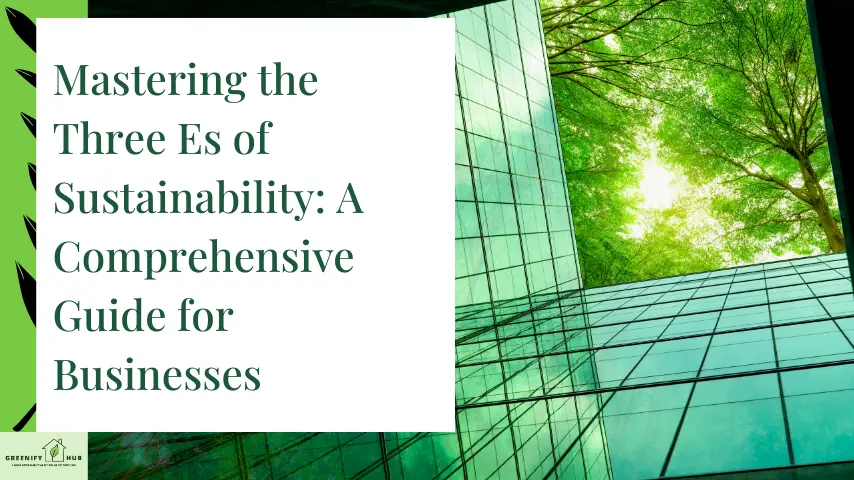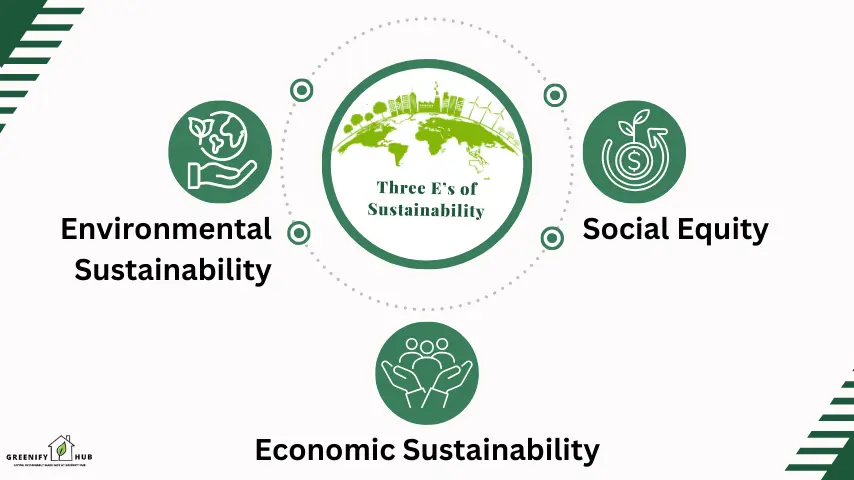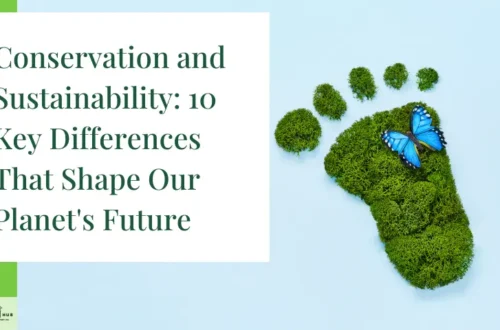Mastering the Three Es of Sustainability: A Comprehensive Guide for Businesses

Sustainability isn’t just a buzzword. It’s a vital concept shaping our future.
But what exactly does it mean? And how can businesses embrace it?
Enter the Three Es of Sustainability: Environment, Economy, and Social Equity.
This powerful framework offers a holistic approach to sustainable development. It ensures we meet our present needs without compromising future generations.
Think of it as a three-legged stool. Each ‘E’ represents a leg, supporting the seat of sustainability. Remove one, and the whole structure topples.
Why is this framework so crucial?
It helps businesses and communities balance their impact on the planet, their economic viability, and their social responsibilities.
Imagine a company that’s eco-friendly but ignores worker rights. Or one that’s profitable but pollutes heavily. Neither is truly sustainable.
The Three Es encourage a more balanced, long-term view of success.
As we dive deeper, we’ll explore each ‘E’ and how they intertwine. We’ll see real-world examples and learn how businesses can integrate this framework into their strategies.
Ready to unlock the power of sustainability? Let’s begin our journey through the Three Es.
The Three Es of Sustainability – Environment, Economy, and Social Equity – provide a comprehensive framework for balanced, long-term sustainable development in business and society.

Environmental Sustainability: Protecting Our Planet
Environmental sustainability is the cornerstone of the Three Es framework. It’s all about safeguarding our planet’s resources for future generations.
But what does this mean in practice?
Imagine a world where businesses operate without harming ecosystems. Where carbon emissions are drastically reduced, and global warming is kept in check.
This isn’t just a dream. It’s a necessity.
Environmental sustainability focuses on:
Climate Change and Its Impact on Businesses
Climate change is no longer a distant threat. It’s here, and it’s affecting businesses now.
Rising temperatures, extreme weather events, and changing precipitation patterns are disrupting supply chains and altering consumer behavior.
For instance, agriculture businesses are facing unpredictable crop yields due to shifting weather patterns.
Coastal real estate companies are grappling with increased flooding risks.
Even the fashion industry is feeling the heat, with changing seasons affecting clothing demand.
But it’s not all doom and gloom. Many businesses are turning this challenge into an opportunity.
They’re innovating to reduce their carbon footprint and appeal to environmentally conscious consumers.
Strategies for Reducing Environmental Footprint
So, how can businesses become more environmentally sustainable?
1. Embrace clean energy: Solar panels on office roofs, wind turbines powering factories – the possibilities are endless.
2. Improve energy efficiency: Simple changes like LED lighting or smart thermostats can make a big difference.
3. Adopt circular economy principles: This involves designing out waste and pollution, keeping products and materials in use, and regenerating natural systems.
4. Go carbon neutral: Companies like Microsoft are leading the way, pledging to be carbon negative by 2030.
Consider Patagonia, the outdoor clothing company. They’ve made sustainability a core part of their brand. They use recycled materials, repair old clothes, and even encourage customers to buy less.
These strategies not only help the environment but can also boost a company’s bottom line through cost savings and increased customer loyalty.
Environmental sustainability involves addressing climate change impacts and implementing strategies to reduce environmental footprints, which can lead to both ecological and economic benefits for businesses.
RELATED: Mastering the 4 Pillars of Sustainability: Your Comprehensive Guide to a Sustainable Future
Economic Sustainability: Balancing Profit and Planet
Economic sustainability is where the green of money meets the green of the environment.
It’s about making sure your business isn’t just profitable today, but will continue to thrive in the future.
Think of it as financial fitness for the long haul.
But here’s the twist: it’s not just about your bottom line. It’s about how your business interacts with the broader economy and environment.
Let’s break it down:
The Role of Sustainable Products in Market Success
Sustainable products are no longer just a niche market. They’re becoming mainstream.
From reusable water bottles to electric cars, consumers are increasingly choosing products that align with their values.
Take Tesla, for example. They’ve revolutionized the auto industry by making electric cars cool and desirable.
Or consider Seventh Generation, a company that’s built its entire brand around eco-friendly household products.
These companies aren’t just doing good for the planet. They’re tapping into a growing market shift towards sustainability.
And the numbers back this up. A Nielsen study found that 73% of global consumers would definitely or probably change their consumption habits to reduce their environmental impact.
ESG Innovation and Business Transformation
ESG (Environmental, Social, and Governance) innovation is reshaping how businesses operate.
It’s not just about creating new sustainable products. It’s about transforming entire business models.
For instance:
– Philips has shifted from selling lightbulbs to providing lighting as a service.
– Interface, a carpet manufacturer, now aims to remove more carbon from the atmosphere than it emits.
– Unilever has committed to making all of its plastic packaging reusable, recyclable, or compostable by 2025.
These transformations aren’t just good for the planet. They’re opening up new revenue streams and future-proofing businesses against changing market forces.
Economic sustainability also means considering the long-term impacts of business decisions.
It’s about asking questions like:
– Will this investment pay off in the long run?
– How will changing regulations affect our business model?
– Are we prepared for potential resource scarcity?
By thinking ahead and adapting to change, businesses can ensure their economic sustainability for years to come.
Economic sustainability involves balancing profitability with environmental responsibility, embracing sustainable product development, and transforming business models through ESG innovation to ensure long-term success in a changing market landscape.
RELATED: Unleashing Cultural Sustainability: 12 Key Strategies for Thriving Communities
Social Equity: Fostering Fair and Inclusive Practices
Social equity, the third ‘E’ in our sustainability framework, is about fairness, justice, and equality.
It’s ensuring that everyone, regardless of their background, has access to opportunities and resources.
But why should businesses care about social equity?
Simple: it’s not just the right thing to do, it’s smart business.
Companies that prioritize social equity often see:
– Increased employee satisfaction and productivity
– Enhanced reputation and brand loyalty
– Access to a wider talent pool
– Better understanding of diverse market needs
Let’s dive deeper into two crucial aspects of social equity in business:
Promoting Workplace Safety and Employee Well-being
A safe and healthy workplace isn’t just a legal requirement. It’s a cornerstone of social equity.
Think about it: How can we talk about fairness if some employees are exposed to unnecessary risks or stress?
Here are some ways businesses are promoting workplace safety and well-being:
1. Implementing robust safety protocols
2. Offering mental health support
3. Providing ergonomic workspaces
4. Encouraging work-life balance
Take Google, for example. They’re famous for their employee-centric culture, offering everything from on-site healthcare to ‘nap pods’.
Or consider Patagonia again. They provide on-site childcare, allowing parents to stay connected with their kids during the workday.
These aren’t just perks. They’re investments in employee well-being that pay off in productivity and loyalty.
Community Engagement and Social Responsibility
Social equity extends beyond the workplace. It’s about how businesses interact with and impact their communities.
This could involve:
– Supporting local initiatives
– Providing job opportunities for underrepresented groups
– Engaging in fair trade practices
– Contributing to social causes
For instance, Ben & Jerry’s isn’t just about ice cream. They’re vocal advocates for social justice issues, from climate change to racial equity.
Or consider the Akshaya Patra Foundation, which partners with businesses to provide meals to schoolchildren in India, promoting both education and nutrition.
These efforts aren’t just charitable. They help build strong, resilient communities – which, in turn, create a stable environment for businesses to thrive.
Remember, social equity isn’t about treating everyone the same. It’s about recognizing and addressing systemic inequalities to create a level playing field.
It’s a ongoing process that requires commitment, reflection, and action.
By embracing social equity, businesses can become powerful forces for positive change in society.
Social equity in business involves fostering fair and inclusive practices both within the workplace and in the broader community, leading to enhanced employee satisfaction, brand reputation, and societal impact.
RELATED: 4 Game-Changing Sustainable Business Practices for Lasting Impact
Integrating the Three Es into Business Strategy
Integrating the Three Es – Environment, Economy, and Social Equity – into your business strategy isn’t just good for the world. It’s good for your bottom line.
But how do you actually do it?
Let’s break it down:
1. Start with a sustainability audit: Assess your current practices. Where are you excelling? Where can you improve?
2. Set clear ESG goals: These should be specific, measurable, and aligned with your business objectives.
3. Embed sustainability into your core operations: It shouldn’t be an afterthought, but a fundamental part of how you do business.
4. Engage your employees: They’re your biggest asset in driving sustainable change.
5. Collaborate with stakeholders: Suppliers, customers, and even competitors can be valuable partners in sustainability efforts.
6. Measure and report your progress: Use established frameworks like the Global Reporting Initiative (GRI) or Sustainability Accounting Standards Board (SASB).
7. Continuously innovate: Sustainability is an ongoing journey, not a destination.
Consider Unilever’s Sustainable Living Plan. It’s not a separate CSR initiative, but a core business strategy that touches every aspect of their operations.
Or look at Interface, the carpet manufacturer. They’ve transformed their entire business model around sustainability, aiming to have a restorative impact on the environment.
Remember, integrating the Three Es isn’t about perfection. It’s about progress.
Start small if you need to. Even minor changes can have a significant impact over time.
The key is to keep the Three Es at the heart of your decision-making process.
Ask yourself: How will this decision impact the environment? Is it economically viable in the long term? Does it promote social equity?
By consistently asking these questions, you’ll naturally steer your business towards a more sustainable future.
Integrating the Three Es into business strategy involves a comprehensive approach, from setting clear goals and embedding sustainability into core operations to engaging stakeholders and continuously innovating, leading to both societal and economic benefits.
RELATED: Economic Sustainability Unveiled: 10 Key Principles for a Thriving Future
Supply Chain Sustainability: A Case Study Approach
Supply chain sustainability is where the rubber meets the road for many businesses.
It’s one thing to make your own operations sustainable. It’s another to ensure your entire supply chain aligns with your sustainability goals.
Let’s look at a real-world example: the Brazilian beef industry.
Why beef? Because cattle ranching is a major driver of deforestation in the Amazon rainforest.
In 2009, major retailers and beef processors in Brazil signed an agreement to stop buying cattle from ranches involved in deforestation.
The result?
A study found that this agreement led to a significant reduction in deforestation for cattle ranching in the Amazon.
But it wasn’t all smooth sailing. Challenges included:
1. Tracing cattle through complex supply chains
2. Ensuring compliance from smaller suppliers
3. Balancing sustainability with economic needs of local communities
What can other businesses learn from this?
1. Collaboration is key: Working with competitors, NGOs, and government bodies can drive industry-wide change.
2. Technology can help: Satellite monitoring and blockchain are being used to improve supply chain transparency.
3. It’s an ongoing process: Continuous monitoring and improvement are necessary.
4. Consider the broader impact: Sustainability efforts should consider economic and social impacts on local communities.
This case study shows that while supply chain sustainability is complex, it’s not impossible.
With commitment, innovation, and collaboration, businesses can drive significant positive change.
The Brazilian beef industry case study demonstrates that achieving supply chain sustainability requires collaboration, technological innovation, and ongoing commitment, while balancing environmental goals with economic and social considerations.
RELATED: 10 Essential Steps to Mastering Social Sustainability: Transform Your Business and Society
ESG Reporting and Compliance in the Modern Business Landscape
ESG reporting isn’t just a buzzword. It’s becoming a business imperative.
But what exactly is it?
ESG stands for Environmental, Social, and Governance. It’s a way for companies to measure and communicate their sustainability efforts.
Why is it important?
1. Investor demand: More investors are using ESG criteria to guide their decisions.
2. Regulatory pressure: Many countries are introducing ESG disclosure requirements.
3. Consumer expectations: People want to support companies that align with their values.
4. Risk management: ESG reporting helps identify and mitigate potential risks.
So, how do you approach ESG reporting?
1. Choose a framework: Popular ones include GRI, SASB, and TCFD.
2. Collect data: This might involve energy usage, diversity metrics, governance policies, etc.
3. Set targets: What do you want to improve? By how much? By when?
4. Report transparently: Be honest about both successes and challenges.
5. Get verified: Third-party assurance can add credibility to your reports.
Remember, ESG reporting isn’t just about ticking boxes. It’s about driving real change in your business.
Take Patagonia’s “The Footprint Chronicles”. It’s an interactive map showing the social and environmental impact of their products.
Or consider Unilever’s Sustainable Living Plan Reports. They provide detailed progress updates on their sustainability goals.
These companies aren’t just reporting. They’re using ESG as a tool for continuous improvement.
The landscape is evolving rapidly. New ESG issues emerge. Reporting standards change.
Stay informed. Adapt your approach. And remember: transparency is key.
ESG reporting is becoming crucial in the modern business landscape, driven by investor demands, regulatory pressures, and consumer expectations, requiring companies to adopt comprehensive frameworks for measuring and communicating their sustainability efforts transparently.
Future Trends in Sustainability for Businesses
The sustainability landscape is evolving rapidly. What’s on the horizon for businesses?
Let’s explore some key trends:
1. AI and sustainability: Artificial intelligence is being used to optimize energy use, predict climate risks, and even design more sustainable products.
2. Circular economy acceleration: More businesses are moving away from the “take-make-waste” model towards circular approaches.
3. Net-zero commitments: Companies aren’t just aiming to reduce emissions. They’re pledging to eliminate them entirely.
4. Biodiversity focus: The UN Biodiversity Conference (COP15) has put nature loss on the business agenda.
5. ESG integration: Sustainability is moving from the periphery to the core of business strategy.
6. Supply chain transparency: Blockchain and other technologies are enabling greater visibility into complex supply chains.
7. Sustainable finance boom: Green bonds and sustainability-linked loans are on the rise.
8. Employee activism: Workers are increasingly pushing their employers to take stronger stances on sustainability issues.
Consider Microsoft’s AI for Earth program. It’s using AI to solve global environmental challenges.
Or look at IKEA’s commitment to become a fully circular business by 2030.
These aren’t just predictions. They’re happening now.
The coming year will likely see these trends accelerate. Businesses that adapt quickly will be best positioned to thrive.
Remember, sustainability isn’t just about compliance. It’s about innovation, resilience, and long-term value creation.
Stay curious. Stay flexible. The future of business is sustainable.
Future sustainability trends for businesses include AI integration, circular economy acceleration, net-zero commitments, biodiversity focus, and increased supply chain transparency, requiring companies to adapt and innovate to stay competitive in the evolving landscape.
RELATED: Environmental Sustainability Unveiled: Key Concepts Shaping Our Future
Overcoming Challenges in Implementing Sustainability Practices
Implementing sustainability practices isn’t always smooth sailing. But don’t let that discourage you.
Let’s tackle some common challenges:
1. Cost concerns: Many assume sustainability is expensive. But it often leads to long-term savings.
Solution: Start small. Focus on energy efficiency or waste reduction. These can show quick returns.
2. Lack of knowledge: Sustainability can seem complex.
Solution: Educate yourself and your team. Consider hiring a sustainability expert or consultant.
3. Resistance to change: People often prefer the status quo.
Solution: Communicate the benefits clearly. Involve employees in the process. Celebrate small wins.
4. Measuring impact: It’s not always easy to quantify sustainability efforts.
Solution: Use established frameworks like GRI or SASB. Set clear, measurable goals.
5. Greenwashing accusations: There’s a fine line between promoting efforts and exaggerating them.
Solution: Be transparent. Back up claims with data. Admit challenges alongside successes.
6. Supply chain complexity: It’s hard to ensure sustainability throughout the entire supply chain.
Solution: Start with tier 1 suppliers. Gradually expand. Use technology to increase visibility.
7. Short-term thinking: Sustainability often requires long-term vision.
Solution: Align sustainability with business strategy. Show how it supports long-term growth and resilience.
Remember, these challenges aren’t unique to you. Many companies face them.
Take Walmart. They faced skepticism when they announced sustainability goals. Now, they’re leaders in sustainable retail.
Or consider Patagonia. They’ve turned sustainability challenges into brand strengths.
The key is persistence. Don’t let setbacks derail you.
Keep asking: How can we tackle climate change? How can we create a more sustainable future?
Every step forward, no matter how small, helps.
Overcoming challenges in implementing sustainability practices requires a strategic approach, including education, clear communication, measurable goals, and a long-term vision, while learning from successful examples in various industries.
RELATED: Conservation and Sustainability: 10 Key Differences That Shape Our Planet’s Future
Conclusion
As we wrap up our exploration of the Three Es of Sustainability, it’s clear that balancing environmental stewardship, economic viability, and social equity is crucial for business success in 2024 and beyond. By integrating these principles into your business strategy, you can drive innovation, reduce risks, and create long-term value for all stakeholders.
Remember, sustainability is not just a buzzword; it’s a fundamental shift in how we approach business and our responsibilities to the planet and society. As you embark on your sustainability journey, consider the strategies we’ve discussed, from reducing your carbon footprint to fostering inclusive workplace practices and engaging with your community.
The path to sustainability may seem challenging, but the rewards – both for your business and the world at large – are immeasurable. By embracing the Three Es, you’re not only securing your company’s future but also contributing to a more sustainable and equitable world for generations to come. So, take that first step and join the growing community of purpose-driven leaders shaping a better tomorrow.





